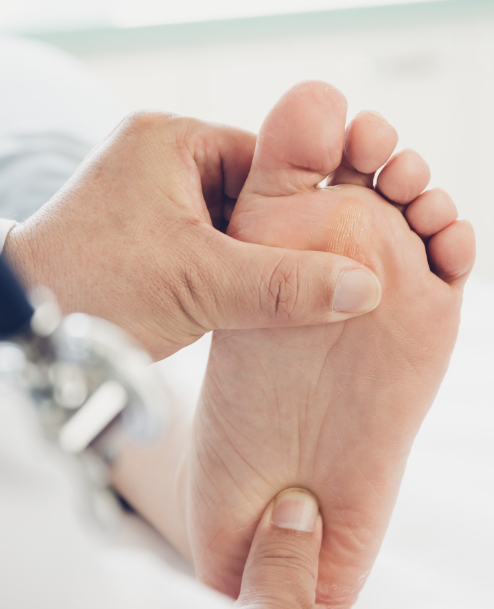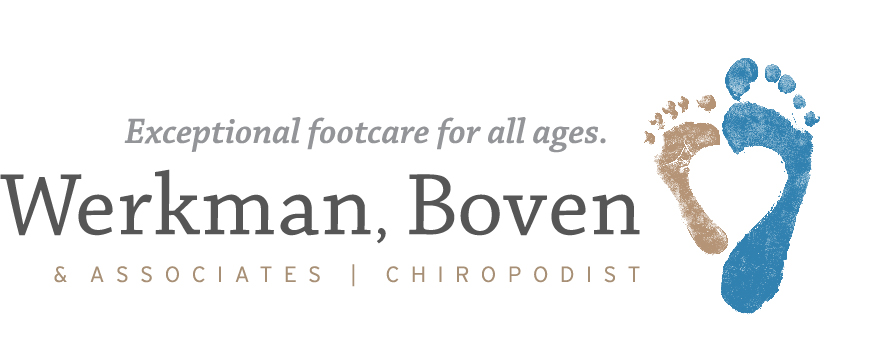Foot Related Conditions
Arthritis & Joint Pain
While there are many types of arthritis, the two most common forms affecting the feet are Osteoarthritis and Rheumatoid Arthritis. Osteoarthritis is the primary form of arthritis and is known as the “wear and tear” disorder. It can affect any joint. The big toe is especially susceptible due to the tremendous pressure placed upon it while walking or running. Osteoarthritis causes the cartilage to erode, which then causes the bone ends to fuse, resulting in stiffness and aching of the joints. Osteoarthritis can also follow a fracture or a bad sprain to the foot.
Rheumatoid Arthritis is a systemic disease, which affects the whole body, including all the joints and muscles in the foot. It affects women more than men and can be inherited. The insides of the joints become swollen and stiff and cause a gradual collapse of the arch; the toes become contracted and pull back. Bunions are a common deformity resulting from rheumatoid arthritis.
ar•thri•tis
acute or chronic inflammation of a joint, often accompanied by pain and structural changes and having diverse causes, such as infection, crystal deposition, or injury.
Symptoms
Rheumatoid Arthritis
- Painful, swollen joints.
- Soles of the feet may feel tender. Patients often refer to this sensation as “walking on pebbles.”
- Corns, calluses and ulcers may develop under the soles of the feet as a result of pressure.
- The stiffness and inflammation are worse in the morning and after periods of inactivity.
Osteoarthritis
- Stiffness and pain in a particular joint.
Causes
Rheumatoid Arthritis
- Stiffness and pain in a particular joint.
Osteoarthritis
- Wear and tear disorder due to repetitive use of a particular joint or after trauma to a joint.
- Weak cartilage and bone structure is also a contributing factor.
Foot Conditions
Rheumatoid Arthritis
- Bunions are common amongst rheumatoid arthritic patients.
- Corns, calluses, thick nails and ulcers can occur due to bunions and other deformities.
Osteoarthritis
- Hallux rigidus may occur; this is a condition where the big toe becomes very stiff and painful to move.
- Corns, calluses and ulcers can occur due to osteoarthritis affecting any bone in the foot.
- If the ankle joint is affected, then a patient may suffer from both foot and postural pain.

What the Chiropodist Will Do
In both forms of arthritis, the treatment applied by the chiropodist will be very similar.
- Treat corns, calluses, thick nails and ulcers, which may involve paring down the callus and corns and applying redistributing padding.
- The prescription of orthopedic footwear.
- Orthosis (insoles – also known as Orthotics) to redistribute pressure away from the affected region. Read what the Arthritis Foundation thinks of custom-made orthotics for arthritis.
- Close communication with other specialists such as; physiotherapists, rheumatologists and specialist nurses.
- In a rheumatoid arthritic patient, close communication between the chiropodist and the family MD may be necessary. The family MD may prescribe the appropriate anti-inflammatory drugs. It is also essential to consider that rheumatoid arthritis is an autoimmune disease. It can affect other parts of the body and may slow down healing response times.
What You Should Not Do
- Ignore the pain.
- Treat any foot complaints yourself with a razor or other sharp instruments.
What You Should Do
- Wear appropriate footwear, which is deep enough to accommodate your feet. Please refer to our Therapeutic Footwear section.
- Have your foot complaints treated by a chiropodist regularly.
- If a joint is swollen, then the use of ice packs and anti-inflammatory creams may be of some benefit.
Articles of Interest
What You Need to Know About Gout
If you’ve ever been woken up by sudden, intense .....
Arthritis & Your Feet
How to Keep Moving Arthritis is a common .....
Arthritis: A Real Pain in the Joint
Arthritis is a painful condition affecting 1 in 5 .....

